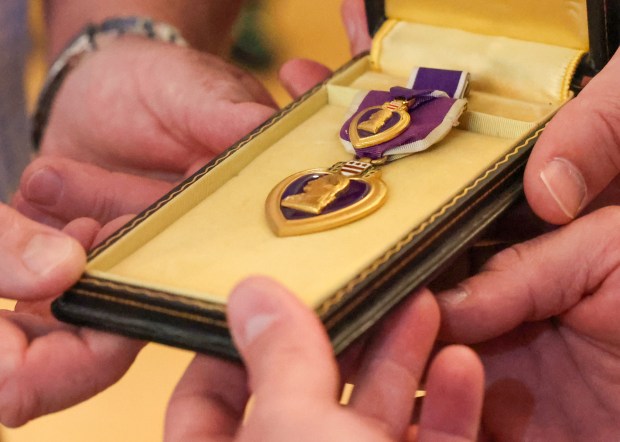One morning last month, Anthony Douglas stood at the front of a classroom at Englewood STEM High School and asked a group of boys how long they thought it took for someone to die from blood loss.
One guessed two minutes. Another guessed five.
“You’re all wrong,” Douglas said. “You get hit in the right spot, you can bleed out in seconds.”
Such are the lessons taught to some teenagers in Chicago, a city just beginning another summer and preparing to grapple with the violence it can bring.
Douglas moved on to the names of the major arteries and how to pressure and pack a wound, hoping to equip the boys with some knowledge of how to respond should somebody be shot where they were standing.
Along with city leaders and public safety advocates, Douglas and his colleagues at the University of Chicago trauma center have spent months preparing. And this summer will bring extra challenges as the city prepares to welcome waves of tourists, delegates and party officials for the Democratic National Convention in late August.
While doctors, nurses and surgeons have made sure they have what they need to treat the wounded in their emergency rooms, city leaders say they are prepared with law enforcement strategies as well as violence interruption and emergency response plans.
Then there are the civilian groups who try to prepare people if they are present for an act of violence, and who try to help those affected by it put their lives back together after the worst has happened. Chicago is increasingly relying on them to step in and aid a city with an uphill road in front of it.
A new police boss
For his first summer at the helm of the Chicago Police Department, Superintendent Larry Snelling faces a balancing act: a major political convention in the middle of the city, along with a host of other large and small summer activities throughout Chicago’s 77 community areas. Meanwhile, CPD faces roughly 2,000 vacant police officer positions.
Police officer scheduling and staffing levels are a frequent point of contention between the city and the Fraternal Order of Police, and this summer figures to be no different. Snelling has said CPD officers will likely have their shifts extended and some days off canceled during the late-August DNC — often the most violent time of the year in Chicago.
According to the Office of Inspector General, the Police Department currently has about 12,000 of its roughly 14,000 positions filled.
Despite the vacancy rate, Snelling said the department would give “as much time off as possible” for officers ahead of the DNC and will dedicate cops to the convention area that week. Then there are the rest of the city’s needs to contend with.
“However, that does not mean we’re going to deplete neighborhoods because we still have a city to protect,” Snelling said.
He said the department will rely on a “neighborhood safety plan” with community groups and update the department’s list of the 35 beats that see the most violence, deploying officers accordingly.
“We’ll make sure that we have an appropriate amount of manpower within those areas to work on those most violent locations,” he said.
Work on the street
Mayor Brandon Johnson announced late last month that the city would train 100 “youth peacekeepers” as part of the effort to quell interpersonal violence over the summer. More than 900 people applied for the positions, according to city officials.
One who is part of that work is Cedric Hawkins. He said his top priority was making sure that the nonaggression agreements between different street gangs on the Far South Side would hold, protecting the lives of some of the city’s highest-risk people.
Hawkins, the strategic initiatives manager at the anti-gun violence organization Chicago CRED, said the agreements are fragile. They’re brokered between gangs and mediated through CRED workers, he said this spring, intended to keep a lid on the bloodshed in the Roseland and Pullman neighborhoods on the Far South Side.
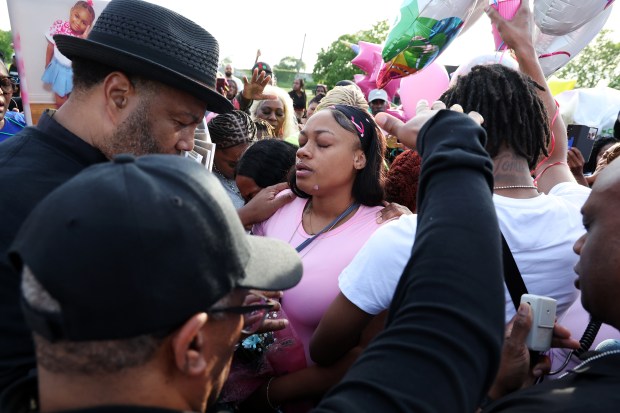
One misplaced threat or misunderstanding can jeopardize a pact, he said. Many of Hawkins’ colleagues spend their years communicating back and forth with different groups to maintain those agreements.
Increasingly common and sometimes just as dangerous are the conflicts that involve members of the same group — trickier to deal with in some ways, he said, because “they (are) looking at you like ‘Why the (expletive) is you in our business?’”
Should a nonaggression agreement break or an argument escalate to shooting, a shot person could get routed to one of the half-dozen trauma centers in and around Chicago that treat the majority of the city’s gunshot wounds.
Preparing early
Days after a pair of springlike days in February saw mass shootings in Rogers Park, Chatham and Grand Crossing, a small group of people formed a circle at a first-aid workshop run by the mutual aid group Ujimaa Medics in Galewood’s Amundsen Park fieldhouse.
The clinic began with an exercise where participants stepped in and out of the circle in response to statements read out loud by a trainer.
“I live in a neighborhood where someone has been shot.” Most participants took a step.
“I know someone who has been shot.” A handful of people stepped in.
“I am afraid I could be shot.” The entire circle took a step inward.

Firearm violence is mostly concentrated among certain populations: A Tribune analysis of city violence data found that since Jan. 1, 2019, the city has recorded more than 3,600 homicides, and more than 14,500 other people were wounded in nonfatal shootings. The data show that in that time more than half of all homicide and aggravated battery victims in the city were Black men less than 40 years old.
On a relatively quiet shift on a Friday this spring, Dr. Abdullah Pratt was sitting in the emergency room at University of Chicago Medical Center wondering what kind of summer it was going to be. That night, Pratt was uneasy.
“We’re seeing the changes in volatility, that’s the way I would describe it,” he said.
In addition to working as an emergency room physician, Pratt runs the organization MedCEEP, an emergency preparedness and violence prevention program aimed at young people on the South and West sides. The group offers EMS and other basic first aid training, trying to offer not only practical skills but also create a sense of agency and calm for participants who may be bystanders to a shooting.
Pratt said that just having the training could help bring down participants’ likelihood of being involved in violence.
“If you teach someone how to save a life, that reduces their chances of taking someone’s life by teaching them ‘Hey, this is what happens when you shoot someone, this is how you save a life,’” he said. “Knowing what to do helps them feel like they can cope.”
Passing knowledge and skills on is also a way to cope for Anthony Douglas, the University of Chicago surgical resident who helped lead the “stop the bleed” training through MedCEEP at Englewood STEM.
Medical professionals ‘hunkering down’
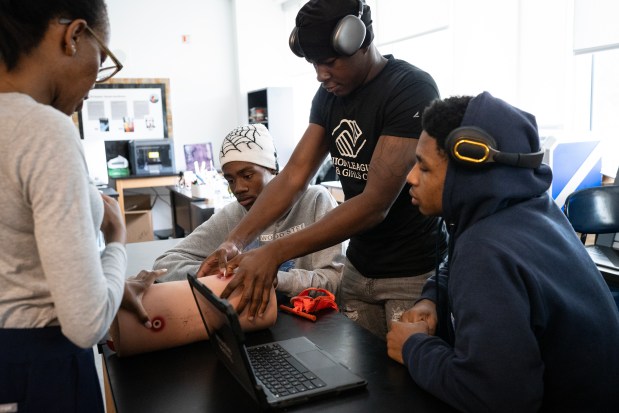
Douglas, speaking shortly after the training in May, said he was bracing himself for the coming months. So was everyone he worked with, he added.
“We’re hunkering down,” he said. “We’re like ‘Wow, it’s summertime and that means that we’re going to see premature deaths and preventable deaths.’”
It means sleepless nights and grieving families. It means blood drives beginning in late winter to make sure patients losing biological reserves can survive. During a shift, he said, it’s hard to process what’s going on, but the weight of the lives can come down hard afterward.
“The more you understand how preventable it is, the more infuriating it is,” he said.
At the MedCEEP clinic, R’Mani Thomas, 15, stuck his hand in the air as far as he could reach and leaned over his desk while he waited his turn to ask a question or three.
“Say you get hit in the head,” he said, putting a palm to the side of his forehead. “Boom.”
Later, he said he enjoyed the training because he thought it was cool, but also because “we might need it, God forbid any situation like that happens.”
Like many of the boys in the room with Pratt and Douglas, R’Mani said he has seen someone get shot or known someone who has been shot.
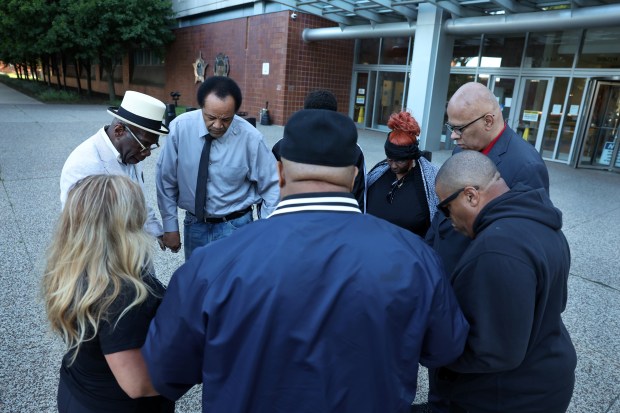
R’Mani wants to study nursing for his college major, he said. His inspiration came from his late mother, who obtained a nursing certification shortly before she died in 2023.
“She made it look so easy,” he said. “I was like, ‘Alright, I want to do it.’”
“For him to pursue that in the name of his mom, I can’t even put it in words how I feel about that,” said R’Mani’s father, Rico Thomas. “He’s a very ambitious and compassionate person.”
He’d seen someone use a tourniquet on TikTok but hadn’t used one himself before the clinic, he said.
He worries about his friends most of the time, he said — both their physical safety, about “little mishaps that could lead to something” and about their mental health.
“It’s not normal to worry, but it is normal to care,” he said.
Douglas, who had demonstrated many of the first-aid techniques that R’Mani and his classmates had learned, said the “stop the bleed” trainings were part of what help him cope with the destruction a trauma center shift can contain. They are a way for him to meet young people before they wind up in the trauma bay.
Convention complicates matters
Officials said they will look to strike a balance between keeping order in the city and running afoul of people’s rights to protest and freedom of movement throughout the convention area and avoid draining the rest of the city of public safety resources.
Deputy Mayor for Community Safety Garien Gatewood said different city agencies would be collaborating on the approach to balancing neighborhood safety with the needs of the DNC. He didn’t offer many specifics about a plan, instead promising further information soon from the mayor’s office and CPD about “what the plans are for particular neighborhoods.”
In response to a recent OIG report that raised concerns about CPD’s level of readiness for the convention, Gatewood said the department would continue training and preparedness.
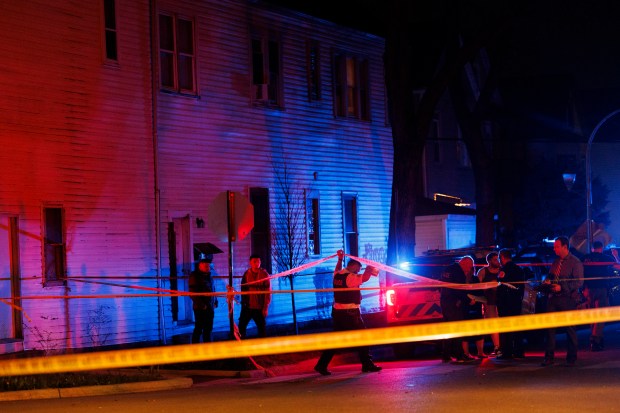
The report acknowledged CPD has improved its written policies and procedures after the fumbled response to unrest in 2020. But OIG also homed in on a lack of community input in those policies and “outdated concepts and tactics” in CPD’s plans to manage crowds.
CPD officials countered that the report is “based only on documents” and did not account for interviews or observation of training sessions in advance of the DNC. The police department disagreed with several findings, arguing it had worked with the parties overseeing compliance with the consent decree to put those updated policies together.
“What we want to see is the safest convention possible, and that’s what CPD wants to see as well,” Gatewood said.
Gatewood said he expected police officers would work with community violence interrupters and other on-the-ground outreach workers who try to prevent and deescalate conflict.
Asked how the city would gauge the success of those programs, Gatewood emphasized a particular metric. It is about “how people feel safe,” he said.
“If you look at the numbers year over year, you see a lot of things moving in the right direction, but still, there’s a need to really invest in more people,” he said. “I think this is how we get there.”
Despite all the work, Chicago got off to a choppy start, perhaps signaling how tough the challenge will be.
Memorial Day Weekend, considered the unofficial start of summer, saw the shootings of 41 people and the deaths of 10, among them 5-year-old Reign Ware. Fifty-three people were shot over the same holiday weekend in 2023.
Work has been picking up for a while for Wilson, a violence interrupter with the organization Public Equity. The organization works to divert people from getting involved in violence and support victims of violent crime through street outreach, case management and other services.
The spring and summer spike in violence is part of the rhythm of his year.
“We already know when it starts,” he said. “When the weather breaks, everyone’s outside.”




